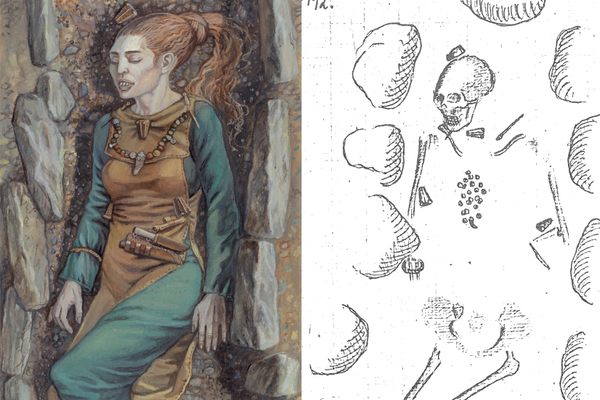How Did Bits of Percy Shelley’s Skull End Up in the New York Public Library?
Bits of Percy Shelley’s skull in the New York Public Library (all photographs by the author)
On the third floor of the New York Public Library’s main branch on Fifth Avenue, before the flow of tourists clots in front of the Rose Main Reading Room, there is a room that seems to be from another era. Crimson velvet glows through the small window, and sunlight reflects off glass-fronted cabinets heavy with old books. You can almost imagine a distinguished older gentleman inside, puffing his cigar at the wooden desk and sipping sherry while perusing the evening papers.
Carl H. Pforzheimer Collection of Shelley and His Circle in the New York Public Library
Inside, there is no older gentleman, just a fresh-faced librarian in forest-green hoodie. He is one of the keepers of room 319, devoted to the more than 25,000 books, manuscripts, and other objects collected by New York financier Carl H. Pforzheimer during the first half of the 20th century. For reasons no one quite understands, Pforzheimer was fascinated with the Romantic poet Percy Shelley. (“It’s a bit of a mystery… Why was this politically conservative entrepreneur so interested in this atheist poet?” the librarian said. “We’re not really sure.”)
Alongside materials devoted to Shelley, his wife Mary (author of Frankenstein), and their circle of free-spirited contemporaries, there is one particularly unusual sliver of plastic. It contains what is probably the only body part stored at the New York Public Library: fragments of Percy Shelley’s skull.
Shelley skull fragments
Or at least purported fragments of Shelley’s skull. Truth be told, they look more like withered leaves. It’s hard to imagine a skull flaking into pieces so tissue-thin, and the brown pattern of veins look like they once held chlorophyll, not blood. But who are we to argue? There is a hand-written attestation, and there was a Sotheby’s sale in 1959. Authenticity seems beside the point.
Attestation to the skull fragments
The library’s skull fragments are said to come from Shelley’s funeral pyre. The poet died in a boating accident in Italy on July 8, 1822 — 191 years ago today — and local health regulations stipulated that his corpse had to be cremated on the beach. Shelley’s friend Edward Trelawny, a sailor and adventurer, ordered a portable iron crematorium constructed and brought to the sand.
According to Trelawny, “more wine was poured over Shelley’s dead body than he had consumed during his life. This with the oil and salt made the yellow flames glisten and quiver. […] The corpse fell open and the heart was laid bare. The frontal bone of the skull, where it had been struck with the mattock, fell off; and, as the back of the head rested on the red-hot bottom bars of the furnace, the brains literally seethed, bubbled, and boiled as in a cauldron, for a very long time.”
Another attestation to the skull fragments
Trelawny also reported that he reached in and snatched out Shelley’s heart. (Or what he thought was the heart—some say it was more likely the poet’s liver). After a brief custody battle the heart went to Mary Shelley, who kept it in a silk bag in her desk until she died. And though he didn’t make a great fuss about doing it, it seems that Trelawny may have also kept some fragments of Shelley’s skull.
The library keeps two hand-written attestations with the skull flakes, both in the hand of Augustus M. Moore, younger brother of the writer George Moore. The papers say the flakes passed from Trelawny to his niece, Emma Taylor, then to the writer Wilfrid Meynell, who gave them as a token of friendship to Augustus in 1879. In 1959, they came up for auction at Sotheby’s, where Pforzheimer must have purchased them. His collection — the thousands of books, papers, and these strange specimens — came to the library in 1986, where it has been ever since. To see the skull fragments, call ahead and buzz at the heavy, locked door on the third floor. Touch them while listening to the stream of tourists chattering outside, and it’s like touching another world.
Bess Lovejoy is the author of Rest in Pieces: The Curious Fates of Famous Corpses. This July, she is the writer-in-residence for Morbid Anatomy Library.
Sources:
NYPL catalogue record
Carl H. Pforzheimer Collection of Shelley and His Circle
Recollections of the last days of Shelley and Byron by Edward Trelawny
Librarians at NYPL








Follow us on Twitter to get the latest on the world's hidden wonders.
Like us on Facebook to get the latest on the world's hidden wonders.
Follow us on Twitter Like us on Facebook